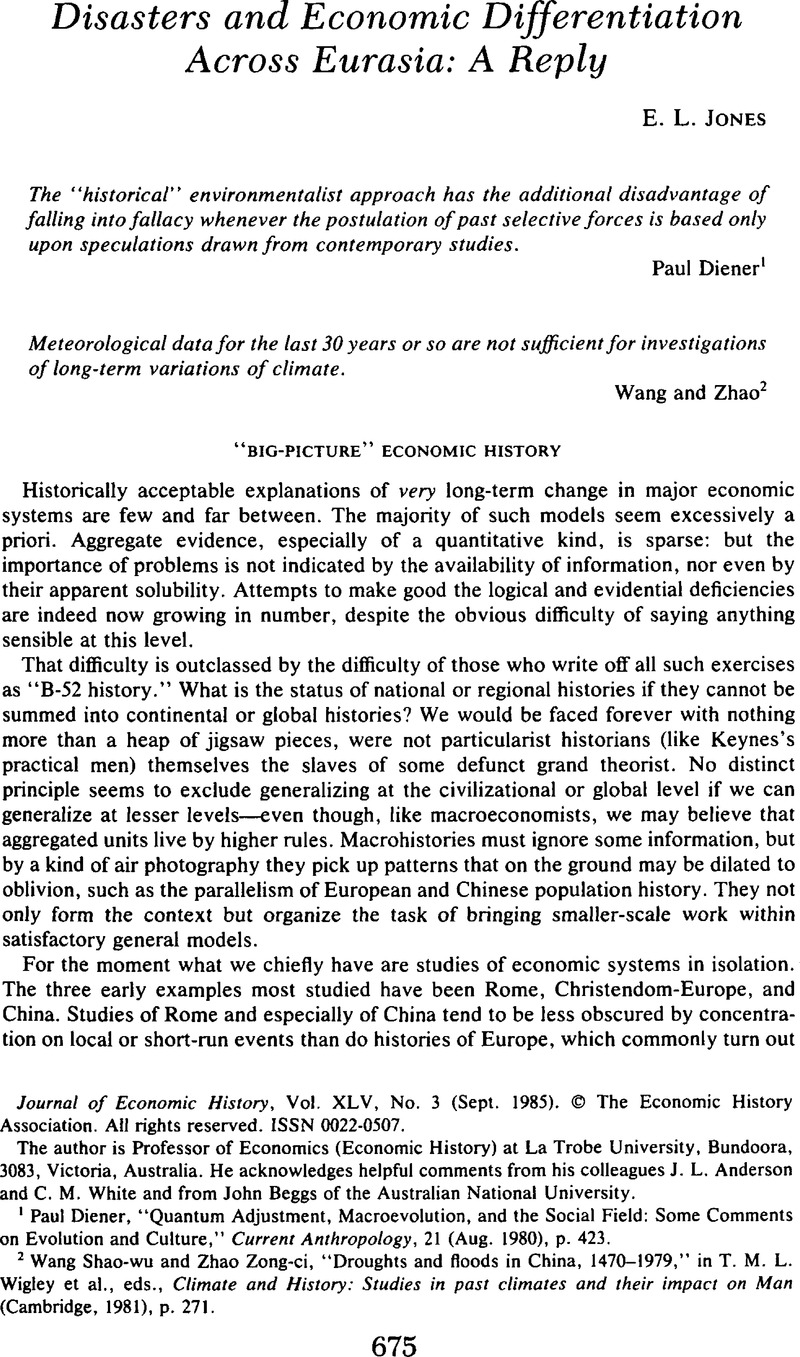Published online by Cambridge University Press: 03 March 2009

He acknowledges helpful comments from his colleagues J. L. Anderson and C. M. White and from John Beggs of the Australian National University.Google Scholar
1 Diener, Paul, “Quantum Adjustment, Macroevolution, and the Social Field: Some Comments on Evolution and Culture,” Current Anthropology, 21 (08 1980), p. 423.CrossRefGoogle Scholar
2 Shao-wu, Wang and Zong-ci, Zhao, “Droughts and floods in China, 1470–1979,” in Wigley, T. M. L. et al. , eds., Climate and History: Studies in past climates and their impact on Man (Cambridge, 1981), p. 271.Google Scholar
3 Jones, Eric, The European Miracle: environments, economies and geopolitics in the history of Europe and Asia (Cambridge, 1981).Google Scholar
4 This opinion is elaborated in my first Faculty Invitation Lecture at the University of Exeter, 1985: “The Suppression and Attainment of Growth in World History”.Google Scholar
5 Marino, John A., “Economic Idylls and Pastoral Realities,” Comparative Studies in Society and History, 24 (04 1982), p. 218. The following passage is drawn from my second Exeter lecture, “The Role of Disasters”.CrossRefGoogle Scholar
6 March, Andrew, The Idea of China (Melbourne, 1974).Google Scholar
7 Abrams, Philip, “Towns and Economic Growth: Some Theories and Problems,” in Abrams, Philip and Wrigley, E. A., eds., Towns in Societies (Cambridge, 1978).Google Scholar
8 See especially his “Climatic Change in European Economic History,” Research in Economic History, 6 (1981), pp. 1–34,Google Scholar and “Review Article: ‘History as a climatologist sees it’,” Journal of Historical Geography, 9, no. 3 (1983), pp. 309–12.CrossRefGoogle Scholar
9 Chenery, Hollis B., “Land: The Effect of Resources on Economic Growth,” in Berrill, Kenneth, ed., Economic Development with Special Reference to East Asia (New York, 1964), p. 48.Google Scholar
10 Sen, Amartya, Poverty and Famtnes: An Essay on Entitlement and Deprivation (Oxford, 1981).Google Scholar
11 pp. 39–40.Google Scholar
12 Anderson, J. L. and Jones, E. L., “Natural Disasters and the Historical Response,” La Trobe University Economics Discussion Paper, No. 3/83, (07 1983), p. 10.Google Scholar
13 Hanley, Susan B., “A High Standard of Living in Nineteenth-Century Japan: Fact or Fantasy?” this JOURNAL, 43 (03 1983), pp. 183–92.Google Scholar
14 McNeill, William H., Plagues and Peoples (Garden City, N.Y., 1976), pp. 139–43.Google Scholar
15 Compare for example Walford, Cornelius, The Insurance Cyclopaedia (London, 1876), vol. 4, pp. 186–96,Google Scholar with Yao, Shan-yu, “The Geographical Distribution of Floods and Droughts in Chinese History, 206 B.C.–A.D. 1911,” Far Eastern Quarterly, 2 (1943), pp. 357–58.Google Scholar
16 This is far from the case. The whole history of climate enterprise has been devoted to showing that climatic variables have changed over time (to identifying, say, the Little Ice Age) as well as asserting that this has mattered. For rainfall see for example Glasspoole, J., “Two Centuries of Rain,” The Meteorological Magazine, 63 (02 1928), pp. 1–6;Google ScholarHare, F. Kenneth, “Climatic Variation and Variability: Empirical Evidence from Meteorological and Other Sources,” in World Meteorological Organization, Proceedings, World Climate Conference, Geneva, 12–2302 1979, No. 537 (Geneva, nd.);Google ScholarLamb, H. H., The Changing Climate (London, 1966);Google ScholarPittock, A. B. et al. , eds., Climatic Change and Variability: A Southern Perspective (Cambridge, 1978);Google Scholar and Pfister, Christian, “The Little Ice Age: Thermal and Wetness Indices for Central Europe,” in Rotberg, Robert I. and Rabb, Theodore K., eds., Climate and History (Princeton, 1981), pp. 85–116.Google Scholar Compared with temperature data, historical rainfall records are few and less easily standardized, but they do exist and are reported and graphed in standard sources. While those from the seventeenth century and after show little global trend (Hare, “Climatic Variation,” pp. 70–71) they display considerable variation from time to time in any given region–depending on one's a priori conception of what “considerable” may be. Decennial averages computed from a number of stations in England from 1727–1926 vary from 87 percent to 108 percent of the mean for 1881–1915. Comparing twenty-year periods, for instance, the variatirin is almost as marked, for example 1727–1746, 92 percent of the mean; 1870–1889, 106 percent of the mean. In these circumstances it is not proper to project modem rainfall patterns backwards.Google Scholar
17 Shao-wu, Wang and Zong-ci, Zhao, “Droughts and floods in China, 1470–1979,” in Wigley, et al. , eds., Climate and History, pp. 271–88.Google Scholar
18 Petterssen's map appears as Figure A.19 in U.S. Committee for the Global Atmospheric Research Program, Understanding Climatic Change (Washington, D.C., 1975).Google Scholar
19 Compare Mallory, Walter H., China, Land of Famine (New York, 1926).Google Scholar
20 Montandon, Raoul, “A propos du projet Ciraolo: une carte mondiale de distribution géographique des calamités,” Revue Internationale de Ia Croix-Rouge, 5 (1923), pp. 271–344;CrossRefGoogle ScholarRe, Munich, World Map of Natural Hazards (Munich, 1978).Google Scholar
21 Basmann, R. L., “The Role of the Economic Historian in Predictive Testing of Proferred ‘Economic Laws’,” Purdue Faculty Papers in Economic History, 1956–1966 (Homewood, Ill., 1967), p. 31.Google Scholar